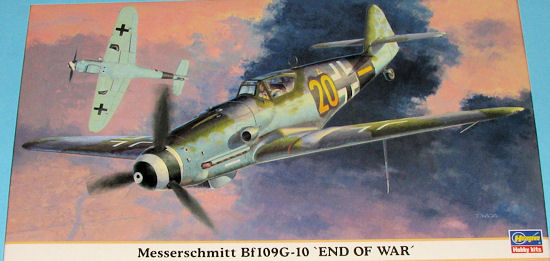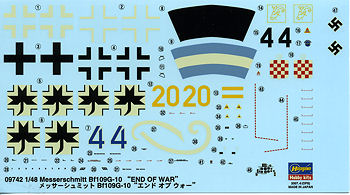
Hasegawa 1/48 Bf-109G-10 'End of War'
| KIT: | Hasegawa 1/48 Bf-109G-10 'End of War' |
| KIT #: | 09742 |
| PRICE: | $27.17 at GreatModels |
| DECALS: | Three Options |
| REVIEWER: | Scott Van Aken |
| NOTES: | Reboxing with new decals |

| HISTORY |
The Bf-109G-10 was a 'stop-gap' aircraft that was based on the G-6 airframe. It incorporated pretty much all of the updates that were to be installed in the Bf-109K-4 except the outer main landing gear doors. Most G-10s had an Erla Haube canopy, wooden tail, and tall tail wheel. There was a mixture of those with the additional wide main wheels with the corresponding wider fairings on the upper wing to allow them to fit and the standard version with the smaller wing fairings. Some G-10s had the shorter tail wheel. All had the newer, more streamlined cowling to cover the larger supercharger. This particular kit has the 'Type 100' cowling where the left side cowling to fuselage fairing is curved.
| THE KIT |
Hasegawa's later 109s are the industry standard and those wanting to build an F-K version in 1/48 scale will gravitate towards this kit. It is typical of when Hasegawa first introduced this kit in the early 1990s. One of the sprues, which contains the wing, has been the same since day one and has been designed for the 109F. G-K modelers will need to scribe an additional panel line and open up the circular wheel well openings. Both tasks take a very short amount of time to complete and most of us are quite used to doing this.
The cockpit is quite complete and will satisfy most builders. However, aftermarket sets generally have a bit higher level of detailing that many seek and so if you wish a higher clarity of detailing, get one of those. The 109G-10 has a different cockpit in terms of arrangement and instrument panel when compared to the G-14 and earlier versions so be sure to get the proper set. The kit provides options for the larger or smaller upper wing fairings so one has to determine which version is being built before gluing the wings together. Since the openings for the small fairings will be easily seen in the wheel well, it would be a good ideal to apply filler after fitting the fairings and before gluing the wings.
The G-10 has a wider set of prop blades and a deeper
oil cooler than earlier versions. Those have been provided. The new fuselage
halves have all the G-10 identifying features like the different cowling, MW-1
tank bulge on the interior and the wider wheels. The
rest is standard Hasegawa 109 with separate flaps and radiator exhaust doors.
I did find it interesting to note that none of the options seem to use a drop
tank. Two different versions are provided as well as the rack for it, so it is
up to you as to whether to add
 one or not.
one or not.
Instructions provide both Gunze and RLM color information, which is good considering that Gunze is no longer sending paints to North America. There are three options provided for you. All appear to be RLM 75/83 over 76 with pretty similar amounts of mottle and a similar upper/lower demarcation line. First is the box art plane from II./JG 52 with the black fuselage band and an areas on the fuselage that was painted over for the aicraft number. Second is a I./JG 300 plane with the blue/white/blue Reich Defense band on the fuselage. The last is a popular subject amongst 109 modelers, the Croatian aircraft with the painted over rear fuselage band and a yellow nose right as was typical for late war Eastern Front planes. Decals are well printed and appear to be the 'older' printed type as the whites appear a bit more to the ivory side of things.
| CONCLUSIONS |
And so there you have it. Another fine Hasegawa 109 reboxing. Probably more 109 kits have been produced by Hasegawa than any other aircraft type and I'm sure this one will prove to be quite popular.
August 2008
You can find this and many other fine kits and accessories at www.greatmodels.com
If you would like your product reviewed fairly and quickly, please contact me or see other details in the Note to Contributors.